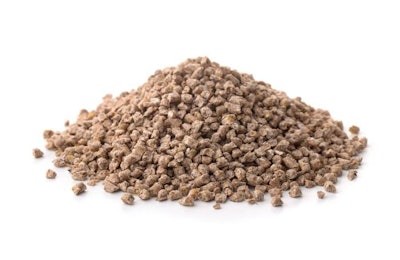
According to data provided by members of the European Feed Manufacturers' Federation (FEFAC), compound feed production in the EU-28 in 2017 reached 159.1 million metric tons, an increase of 1.5 percent compared with 2016.
Cattle feed saw the highest growth rate (+3.6 percent), whereas poultry and pig feed recorded more moderate production increases (+1.4 and +1.0 percent, respectively). On the pig feed side, the evolution year to year is positive again, after a slight setback in 2016.
The still persistent effects of African swine fever (ASF) in Eastern Europe weighed significantly on the development of pig meat production. The exception remains Poland, which, despite the permanent ASF threat, managed to increase its production by 7 percent.
The picture is extremely contrasted throughout Europe for cattle feed: Northern Europen countries have recorded growth of volumes between 4 and 12 percent, whereas Southern countries, in general, have seen their production stabilizing, although Spain set another production record. Among Eastern countries, only Poland and Bulgaria have seen a significant increase of production (8 percent and more).
This year again, the avian influenza (AI) outbreak affected several poultry-producing regions of Europe, in particular France and Hungary. However, this was largely offset by an increase in many other countries, leading to an overall increase of +1.4 percent in 2017 vs. 2016, thus confirming its position of leading segment of EU industrial compound feed production, well ahead of pig feed.
For the fourth year in a row, Poland was one of the best performing countries, with annual growth of +7.5 percent, boosted by the demand for poultry feed, which has turned Poland into the largest poultry-producing country in the EU, but also a +8 percent increase in cattle feed. All large feed producing countries (above 10 million metric tons per year) have seen their production grow (between 0.4 and 3.5 percent), with the exception of France which is still struggling to recover from the AI outbreak. Germany remains the top leading producer country trailed closed by Spain, thus widening the gap to France which remains in third position.
Forecast for 2018
FEFAC market experts are relatively prudent concerning industrial compound feed production in 2018. The dairy sector still needs to recover from the severe milk price crisis and get rid of the vast stocks of skimmed milk powder, leading FEFAC experts to anticipate a reduction of the demand for cattle feed between 0.5 and 1 percent.
Several factors will weigh in on the development of EU pig production. The effective development of pig meat production in the EU and the subsequent demand for pig feed depend to a certain extent on the global demand for pig meat, which is expected to stabilize. The development of national/local legislation on manure and phosphorous emissions can also have an impact. However, the main uncertainty remains in the possible expansion of the area affected by ASF. A slight reduction of the production of pig feed by 0.5-1 percent is, therefore, possible.
While poultry exports will continue to be affected by restrictions in third countries due to AI, the persistent trend to increase consumption of poultry meat in the EU is expected to maintain the demand in poultry feed at the level of 2017, despite constraints due to a trend in certain Western countries to reduce stocking density in poultry holding triggered by animal welfare concerns. Overall, FEFAC experts predict a stabilization or moderate reduction of compound feed production (0 to -0.5 percent).















